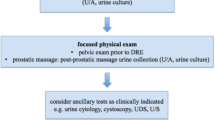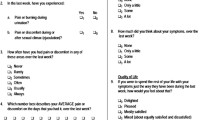Abstract
Purpose of Review
This review seeks to review up to date literature surrounding the chronic prostatitis/chronic pelvic pain syndrome (CP/CPPS) to provide an overview of the subject. The review includes current understandings of the syndrome, the use of UPOINT, novel treatment strategies and future targets for management.
Recent Findings
Using the US National Institute of Health Chronic Prostatitis Symptom Index helps clinicians to monitor prostatitis symptoms, whilst using UPOINT as guidance of therapies based on patient phenotype(s) has advanced our ability to treat patients suffering with CP/CPPS. Furthermore, novel treatments look beyond traditional prostatic targets to treat CP/CPPS.
Summary
Whilst the use of UPOINT has opened up new targets for the treatment of CP/CPPS, more work is needed to both improve the quality of trials assessing them, as well as further elucidate the underlying pathophysiology behind this troublesome syndrome.
Similar content being viewed by others
References
Papers of particular interest, published recently, have been highlighted as: • Of importance •• Of major importance
Sandhu J, Tu HYV. Recent advances in managing chronic prostatitis/chronic pelvic pain syndrome. F1000Res. 2017;6:F1000 Faculty Rev-1747.
Nickel JC, Shoskes DA. Phenotypic approach to the management of the chronic prostatitis/chronic pelvic pain syndrome. BJUI. 2010;106:1252–63.
Nickel JC. The three as of chronic prostatitis therapy: antibiotics, α-blockers and anti-inflammatories. What is the evidence? BJUI. 2004;94:1230–3.
Thankkinstian A, Attia J, Anothaisintawee T, Nickel JC. α-blockers, antibiotics and anti-inflammatories have a role in the management of chronic prostatitis/chronic pelvic pain syndrome. BJUI. 2012;110:1014–22.
Krieger JN, Lee SW, Jeon J, Cheah PY, Liong ML, Riley DE. Epidemiology of prostatitis. Int J Antimicrob Agents. 2007;31(Suppl1):S85–90.
•• Anderson RU, Wise D, Nathanson BH. Chronic prostatitis and/or chronic pelvic pain as a psychoneuromuscular disorder - a meta-analysis. Urology. 2018;120:23–9 Current evidence showing benefit of treating CP/CPPS as psychoneuromuscular disorder.
DeWitt-Foy ME, Nickel JC, Shoskes DA. Management of chronic prostatitis/chronic pelvic pain syndrome. Eur Urol Focus. 2019;5(1):2–4.
Shoskes DA, Nickel JC, Dolinga R, Prots D. Clinical phenotyping of patients with chronic prostatitis/chronic pelvic pain syndrome and correlation with symptom severity. Urology. 2009;73(3):538–42.
Rees J, Abrahams M, Doble A, Cooper A. Diagnosis and treatment of chronic bacterial prostatitis and chronic prostatitis/chronic pelvic pain syndrome: a consensus guideline. BJUI. 2015;116:509–25.
Lipsky BA, Byren I, Hoey CT. Treatment of bacterial prostatitis. CID. 2010;50:1641–52.
Tsivkovskii R, Sabet M, Tarazi Z, Griffith DC, Lomovskaya O, Dudley MN. Levofloxacin reduces inflammatory cytokine levels in human bronchial epithelia cells: implications for aerosol MP-376 (levofloxacin solution for inhalation) treatment of chronic pulmonary infections. FEMS Immunol Med Microbiol. 2011;61(2):141–6.
Ogino H, Fujii M, Ono M, Maezawa K, Kizu J, Hori S. In vivo and in vitro effects of fluoroquinolones on lipopolysaccharide-induced pro-inflammatory cytokine production. J Infect Chemother. 2009;15(3):168–73.
Roehrborn CG. Alfuzosin: overview of pharmacokinetics, safety, and efficacy of a clinically uroselective α-blocker. Urology. 2001;58(6):55–63.
Kirby RS, Lowe D, Bultitude MI, Shuttleworth KE. Intraprostatic urinary reflux: an etiological factor in abacterial prostatitis. Br J Urol. 1982;54:729–31.
Duclos AJ, Lee CT, Shoskes DA. Current treatment options in the management of chronic prostatitis. Ther Clin Risk Manag. 2007;3(4):507–12.
Hochreiter WW. Anti-inflammatory therapies for chronic prostatitis. Eur Urol Suppl. 2003;2(2):30–3.
Anothaisintawee T, Attia J, Nickel CJ, Thammakraisorn S, et al. Management of chronic prostatitis/chronic pelvic pain syndrome: a systematic review and network meta-analysis. JAMA. 2011;305(1):78–86.
Wagenlehner FM, Schneider H, Ludwig M, Schnitker J, et al. A pollen extract (Cernilton) in patients with inflammatory chronic prostatitis-chronic pelvic pain syndrome: a multicentre, randomised, prospective, double-blind, placebo-controlled phase 3 study. Eur Urol. 2009;56(3):544–51.
Nickel JC, Shoskes DA, Wagenlehner FM. Management of chronic prostatitis/chronic pelvic pain syndrome (CP/CPPS): the studies, the evidence, and the impact. World J Urol. 2013;31(4):747–53.
Bates SM, Hill VA, Anderson JB, Chapple CR, et al. A prospective, randomized, double-blind trial to evaluate the role of a short reducing course of oral corticosteroid therapy in the treatment of chronic prostatitis/chronic pelvic pain syndrome. BJU Int. 2007;99(2):355–9.
Kessler TM, Mordasini L, Weisstanner C, Jüni P, da Costa BR, Wiest R, et al. Sono-electro-magnetic therapy for treating chronic pelvic pain syndrome in men: a randomized, placebo-controlled, double-blind trial. PLoS One. 2014;9(12):e113368.
Ateya A, Fayez A, Hani R, Zohdy W, Gabbar MA, Shamloul R. Evaluation of prostatic massage in treatment of chronic prostatitis. Urology. 2006;67(4):674–8.
• Magri V, Wagenlehner F, Perletti G, Schneider S. Use of the UPOINT chronic prostatitis/chronic pelvic pain syndrome classification in European patient cohorts: sexual function domain improves correlations. J Urol. 2010;184(6):2339–45 Creation of sexual function domain further helps corrolate UPOINT to clinical phenotyping.
Shoskes DA, Nickel JC, Kattan MW. Phenotypically directed multimodal therapy for chronic prostatitis/chronic pelvic pain syndrome: a prospective study using UPOINT. Urology. 2010;75(6):1249–53.
Guan X, Zhao C, Ou ZY, Wang L, et al. Use of the UPOINT phenotype system in treating Chinese patients with chronic prostatitis/chronic pelvic pain syndrome: a prospective study. Asian J Androl. 2015;17(1):120–3.
Qin Z, Wu J, Zhou J, Liu Z. Systematic review of acupuncture for chronic prostatitis/chronic pelvic pain syndrome. Medicine (Baltimore). 2016;95(11):e3095.
• Liu BP, Wang YT, Chen SD. Effect of acupuncture on clinical symptoms and laboratory indicators for chronic prostatitis/chronic pelvic pain syndrome: a systematic review and meta-analysis. Int Urol Nephrol. 2016;48(12):1977–91 Meta analysis suggesting the benefits of use of acupuncture in CP/CPPS.
Zhang R, Chomistek AK, Dimitrakoff JD, Giovannucci EL, et al. Physical activity and chronic prostatitis/chronic pelvic pain syndrome. Med Sci Sports Exerc. 2015;47(4):757–64.
Giubilei G, Mondaini N, Minervini A, Saieva C, Lapini A, Serni S, et al. Physical activity of men with chronic prostatitis/chronic pelvic pain syndrome not satisfied with conventional treatments--could it represent a valid option? The physical activity and male pelvic pain trial: a double-blind, randomized study. J Urol. 2007;177(1):159–65.
Petersen AM, Pedersen BK. The anti-inflammatory effect of exercise. J Appl Physiol. 2005;98(4):1154–62.
Nickel JC, Tripp DA, Chuai S, Litwin, et al. Psychosocial variables affect the quality of life of men with chronic prostatitis/chronic pelvic pain syndrome. BJUI. 2007;101:59–64.
Tripp DA, Nickel CJ, Wang Y, Litwin MS, et al. Catastrophizing and pain-contingent rest predict patient adjustment in men with chronic prostatitis/chronic pelvic pain syndrome. J Pain. 2006;7(10):697–708.
Brünahl CA, Klotz SGR, Dybowski C, Riegel B. Combined cognitive-behavioural and physiotherapeutic therapy for patients with chronic pelvic pain syndrome (COMBI-CPPS): study protocol for a controlled feasibility trial. Trials. 2018;19(1):20.
Magistro G, Wagenlehner FM, Grabe M, Weidner W, et al. Contemporary management of chronic prostatitis/chronic pelvic pain syndrome. Eur Urol. 2016;69(2):286–97.
Nickel CJ, Shoskes DA, Roehrborn CG, Moyad M. Nutraceuticals in prostate disease: the urologist’s role. Rev Urol. 2008;10(3):192–206.
Shoskes DA, Zeitlin SI, Shahed A, Rajfer J. Quercetin in men with category III chronic prostatitis: a preliminary prospective, double-blind, placebo-controlled trial. Urology. 1999;54(6):960–3.
Shahed AR, Shoskes DA. Oxidative stress in prostatic fluid of patients with chronic pelvic pain syndrome: correlation with gram positive bacterial growth and treatment response. J Androl. 2000;21(5):669–75.
• Morgia G, Russo GI, Urzi D, Privitera S, et al. A phase II, randomized, single-blinded, placebo-controlled clinical trial on the efficacy of Curcumina and Calendula suppositories for the treatment of patients with chronic prostatitis/chronic pelvic pain syndrome type III. Arch Ital Urol Androl. 2017;89(2):110–3 RCT showing benefit of using phytotherapies for CP/CPPS.
Jin C, Chen Z, Zhang J. Meta-analysis of the efficacy of Ningmitai capsule on the treatment of chronic prostatitis in China. Medicine(Baltimore). 2018;97(33):e11840.
Zhang K, Zeng X, Chen Y, Zhao R, Wang H, Wu J. Therapeutic effects of Qian-Yu decoction and its three extracts on carrageenan-induced chronic prostatitis/chronic pelvic pain syndrome in rats. BMC Complement Altern Med. 2017;17(1):75.
Barnes RW, Hadley HL, O’Donoghue EP. Transurethral resection of the prostate for chronic bacterial prostatitis. Prostate. 1982;3(3):215–9.
•• Chopra S, Satkunasivam R, Aron M. Feasibility of robotic radical prostatectomy for medication refractory chronic prostatitis/chronic pelvic pain syndrome: initial results. Indian J Urol. 2016;32(3):238–41 Case report on the use of surgery for CP/CPPS in appropriately selected patients.
Frazier HA, Spalding TH, Paulson DF. Total prostatoseminal vesiculectomy in the treatment of debilitating perineal pain. J Urol. 1992;148(2):409–11.
Krongrad A, Shenghan L. Laparoscopic prostatectomy for severely symptomatic treatment-refractory chronic prostatitis: preliminary observations from an ongoing phase II clinical trial. UroToday Int J. 2011;4(2):1944–5784.
Franco JVA, Turk T, Xiao YT, Iakhno S, et al. Non-pharmacological interventions for treating chronic prostatitis/chronic pelvic pain syndrome: a Cochrane systematic review. Cochrane Database Syst Rev. 2018;1:CD01255.
Abdel-Meguid TA, Mosli HA, Farsi H, Alsayyad A, Tayib A, Sait M, et al. Treatment of refractory category III nonbacterial chronic prostatitis/chronic pelvic pain syndrome with intraprostatic injection of onabotulinumtoxin A: a prospective controlled study. Can J Urol. 2018;25(2):9273–80.
Hong H, Kim CS, Maeng S. Effects of pumpkin seed oil and saw palmetto oil in Korean men with symptomatic benign prostatic hyperplasia. Nutr Res Pract. 2009;3(4):323–7.
Tantawy SA, Elgohary HM, Kamel DM. Trans-perineal pumpkin seed oil phonophoresis as an adjunctive treatment for chronic nonbacterial prostatitis. Res Rep Urol. 2018;10:95–101.
Hajighorbani M, Ahmadi-Hamedani M, Shahab E, Hayati F, et al. Evaluation of the protective effect of pentoxifylline on carrageenan-induced chronic non-bacterial prostatitis in rats. Inflammopharmacology. 2017;25(3):343–50.
Prins GS, Korach KS. The role of estrogens and estrogen receptors in normal prostate growth and disease. Steroids. 2008;73(3):233–44.
Tiwari-Woodruff S, Voskuhl RR. Neuroprotective and anti-inflammatory effects of estrogen receptor ligand treatment in mice. J Neurol Sci. 2009;286(1–2):81–5.
Acar D, Cayan S, Aktaş S, Tek M. The effect of tamoxifen on bladder functions and histology, and the role of estrogen receptor beta in a rat chemical cystitis model. Neurourol Urodyn. 2007;26(2):309–16.
•• Mizoguchi S, Mori K, Wang Z, Liu T, Funahashi Y, Sato F, et al. Effects of estrogen receptor β stimulation in a rat model of non-bacterial prostatic inflammation. Prostate. 2017;77(7):803–11 New research with promising novel target for management of CP/CPPS.
Author information
Authors and Affiliations
Corresponding author
Ethics declarations
Conflict of Interest
The authors declare that they have no conflicts of interest.
Human and Animal Rights
This article does not contain any studies with human or animal subjects performed by any of the authors.
Additional information
Publisher’s Note
Springer Nature remains neutral with regard to jurisdictional claims in published maps and institutional affiliations.
This article is part of the Topical Collection on Inflammatory/Infectious Bladder Disorders
Rights and permissions
About this article
Cite this article
Farmer, T., Johnston, M., Milica, A. et al. Chronic Prostatitis/Chronic Pelvic Pain Syndrome: a Literature Review of NIH III Prostatitis. Curr Bladder Dysfunct Rep 14, 83–89 (2019). https://doi.org/10.1007/s11884-019-00508-9
Published:
Issue Date:
DOI: https://doi.org/10.1007/s11884-019-00508-9




